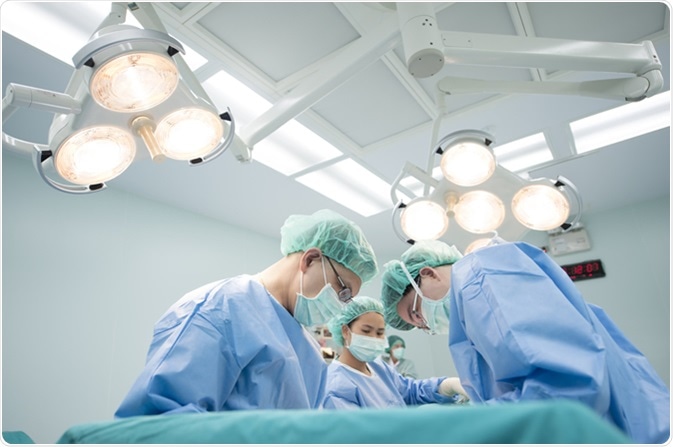Ventouse or forceps delivery comes under the category of assisted or operative vaginal delivery. This is usually indicated in women who have prolonged second stage of labor, nonreassuring fetal heart tracing, any condition which requires the second stage to be shortened (such as heart disease), or if the woman is simply too exhausted to push the baby out.
Assisted vaginal delivery may avoid the need for a future repeat cesarean section (or C-section) unlike the increased risk after a cesarean section. It is also associated with a lower hospital stay and fewer readmissions than after cesarean section.

Image Credit: SweetLeMontea / Shutterstock
Contraindications to Assisted Vaginal Delivery
There are certain contraindications to the use of assisted delivery techniques. One of the examples is when criteria for the use of instrumental delivery are not met. Other examples include fetal age below 34 weeks or an estimated fetal weight below 2500 grams, as well as unwilling patient.
A cesarean rather than assisted vaginal delivery may also be preferred in some cases where there is a suspicion of fetal position, suspected fetal macrosomia above 4500 grams, as well as the lack of adequate anesthesia. Furthermore, it should be pursued when scalp blood samples have been already taken, or scalp electrodes attempted to be placed several times.
Benefits of Vacuum over Forceps Extraction
- Vacuum extraction is becoming the norm in many centres due to the lesser incidence of severe perineal lacerations when using this technique.
- They also have the advantage of not needing general or pudendal block anesthesia
- Postpartum perineal pain is reduced compared to forceps use
- Overall cesarean section rate is lower with vacuum extraction
Are forceps or vacuum extractors commonly used in birth? What are the risks?
Benefits of Forceps over Vacuum Extraction
- Delivery can be achieved faster
- Rate of successful vaginal delivery is higher compared to vacuum extraction
- The incidence of fetal scalp injuries such as cephalhematoma and subgaleal hematomas is lower following the use of forceps.
- They can be used to rotate the fetal head into the right position and so facilitate normal delivery
- They do not detach from the fetal head during traction if correctly applied
- In some conditions they are safer to use than either vacuum or Cesarean section, such as in assisted delivery or preterm infants, delivery of the head during assisted breech delivery, delivery of a fetus in face presentation, in conditions which contraindicate maternal expulsive efforts, if fetal coagulopathy or thrombocytopenia is present, as well as when delivery is done under epidural anesthesia which could inhibit maternal expulsive efforts
- Assisted delivery under general anesthesia
- Cord prolapse during the second stage
Complications of Assisted Vaginal Delivery
Complications may involve either the mother or the fetus. They are more likely to occur if the criteria for assisted vaginal delivery are not fulfilled, if the operator is not adequately skilled or when excessive force is used.
The operator employs forceps repeatedly or switches to vacuum extraction after one unsuccessful forceps attempt, instead of proceeding to cesarean section.
Maternal Complications of Operative Vaginal Delivery
The mother may suffer various complications following operative vaginal delivery. Perineal lacerations of severe degree may ensue, as well as anal injuries which may lead to long-term incontinence or urgency in 2-4 of every ten patients following assisted delivery. Of course, this is often coupled with perineal pain at delivery and in the postpartum.
Blood loss and anemia are other important complications, while post-partum urinary retention can be observed. Urinary incontinence, urinary fistula, and pelvic organ prolapse are long-term complications which may first be recognized several months or even years after the event.
Maternal trauma to the soft tissues of and around the birth canal occurs in almost half of all forceps deliveries and over a third of vacuum extractions using the silastic cup. Rigid cups were associated with these complications in just over a fifth of all cases.
Fetal Complications
Vacuum extraction may cause fetal injuries in about 5 percent of babies, including scalp lacerations, cephalohematomas, subgaleal hematomas, intracranial haemorrhage, facial nerve palsy, hyperbilirubinemia and retinal haemorrhage. Forceps delivery may also cause fetal injuries, though rare.
Risk factors for failure of assisted vaginal delivery include a body mass index (BMI) over 30, large fetus, malpositioned fetal head (especially occiput posterior), as well as high station of presenting part.
In the presence of such factors, the patient may be transferred to the operating theater to provide for a cesarean section in case the assisted delivery is unsuccessful.
References
Further Reading
Last Updated: Feb 26, 2019